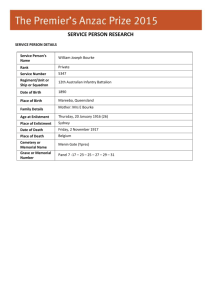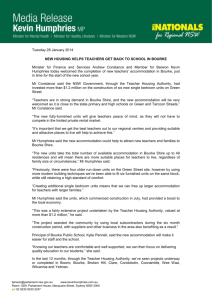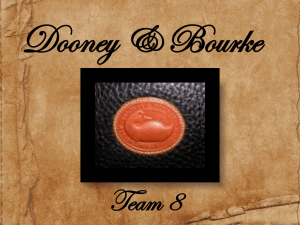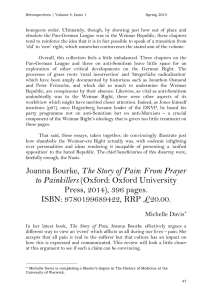Notes week 3
advertisement
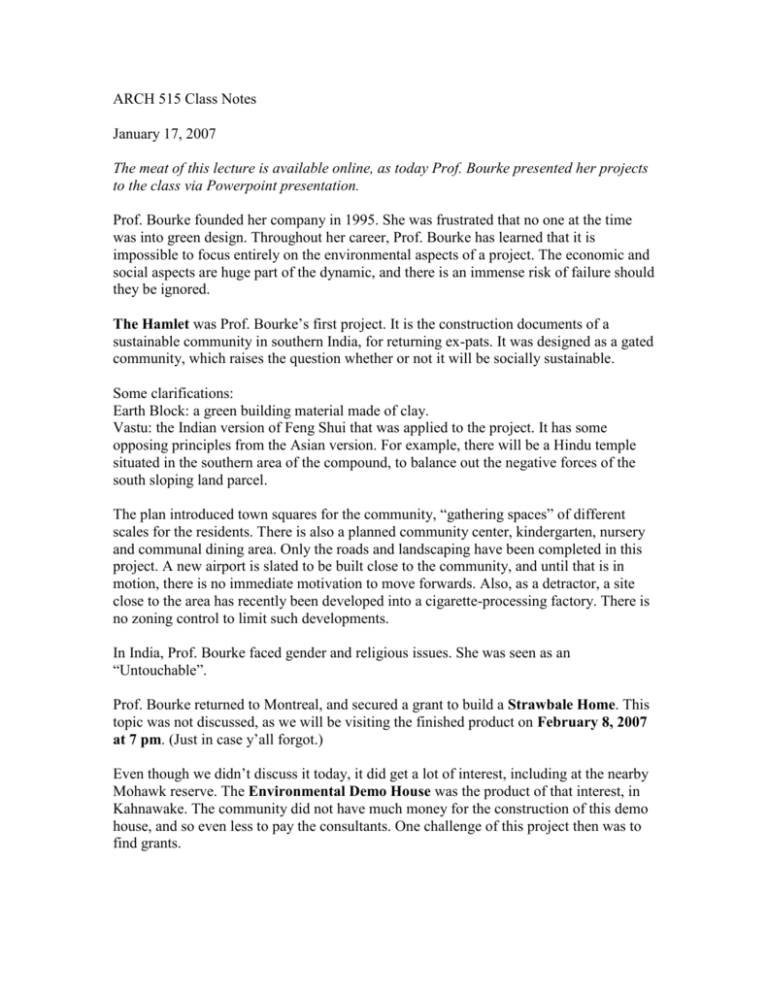
ARCH 515 Class Notes January 17, 2007 The meat of this lecture is available online, as today Prof. Bourke presented her projects to the class via Powerpoint presentation. Prof. Bourke founded her company in 1995. She was frustrated that no one at the time was into green design. Throughout her career, Prof. Bourke has learned that it is impossible to focus entirely on the environmental aspects of a project. The economic and social aspects are huge part of the dynamic, and there is an immense risk of failure should they be ignored. The Hamlet was Prof. Bourke’s first project. It is the construction documents of a sustainable community in southern India, for returning ex-pats. It was designed as a gated community, which raises the question whether or not it will be socially sustainable. Some clarifications: Earth Block: a green building material made of clay. Vastu: the Indian version of Feng Shui that was applied to the project. It has some opposing principles from the Asian version. For example, there will be a Hindu temple situated in the southern area of the compound, to balance out the negative forces of the south sloping land parcel. The plan introduced town squares for the community, “gathering spaces” of different scales for the residents. There is also a planned community center, kindergarten, nursery and communal dining area. Only the roads and landscaping have been completed in this project. A new airport is slated to be built close to the community, and until that is in motion, there is no immediate motivation to move forwards. Also, as a detractor, a site close to the area has recently been developed into a cigarette-processing factory. There is no zoning control to limit such developments. In India, Prof. Bourke faced gender and religious issues. She was seen as an “Untouchable”. Prof. Bourke returned to Montreal, and secured a grant to build a Strawbale Home. This topic was not discussed, as we will be visiting the finished product on February 8, 2007 at 7 pm. (Just in case y’all forgot.) Even though we didn’t discuss it today, it did get a lot of interest, including at the nearby Mohawk reserve. The Environmental Demo House was the product of that interest, in Kahnawake. The community did not have much money for the construction of this demo house, and so even less to pay the consultants. One challenge of this project then was to find grants. Initially, the community wanted to build one model home that could be imitated. Prof. Bourke suggested designing a green neighborhood, and the idea was readily accepted. The project includes plans for black and grey water treatment, using septic tanks, mechanical aeration, reed beds and then ponds. The ponds were sized such that they contained enough water for firefighting purposes. There was one year of pre-design research of the social constraints that exist in a Mohawk community. As Prof. Bourke, the consultant, was an outsider this would be significant for design decisions. Unfortunately, she was not allowed to do the research and the community took it upon themselves; Prof. Bourke only suggested topics to explore. The resulting information, although good, did not expound on certain subjects in great enough detail that lead to misunderstandings about, for example, the notion of family. This affected the layout of the design. The Mohawks are given ¼ acre per family, to build a home. Using a traditional idea, part of each plot in the neighborhood was allocated as common space. Each lot can have a second house added on in the future, if the family grows too large. Thus, the primary home on the lot had to be aligned in a certain way to allow for additions. The model home did not have a finished basement, as is common on the reserve. These basements are used as bedrooms to fit all the occupants, but often affect quality of health. The high water table in the area can encourage mold, among other things. To replace this necessary space, the eaves of the model home were adapted as sleeping quarters. The demo house was completed in 2002, as a big success. There is now a grant to push the neighborhood through council, but it is on hold. The initial plan was to settle the people who requested new houses in this green neighborhood, a forced community. Since the plan has yet to be authorized by council, a natural community is growing instead, of people who support the principles of the area. These two communities were built on Greenfield sites, and as suburban construction, have lower density than city living and less sustainability. Unfortunately, in the two cases, the developer already had the site. None of Prof. Bourke’s projects have been LEED certified, although she has the credentials. (To see more about LEED, visit http://www.usgbc.org/DisplayPage.aspx?CategoryID=19.) Her projects apply best practices, a prescriptive standard. LEED standard, on the other hand, models building design for energy results, and is a performance based standard. The final project we talked about today was the Eco-Lodge, at Lake Waposite. This 5,000 ft2 lodge catered to German, American and French tourists interested in the northern Canadian wilderness. The project has been in motion for 6 years, and throughout that time, many people have cycled through the project management position, leading to delays. There was also the language barrier, as most of the community speaks Cree as a first language. Prof. Bourke had a lot of freedom on this project, she was able to use traditional skills to build the lodge, and design for a high environmental performance. To involve to community, all blankets in the lodge were handmade, and birch bark snowflake patterns were translated into a screen motif. There was no unifying vision for this project, and at the moment it is halted, at half completion of construction documents. There exists a gap between traditional community economic principles and modern, southern ones. This group of people was the last Cree group to settle, in Quebec, in 1985. They were not part of the James Bay agreement, and thus nomadic. This provides challenges in the community. They are not used to agriculture, so the idea of using a reed bed indoors as water treatment has met some resistance. The plants will have to be cared for. This design has little flexibility for future design changes. It was done specifically to be a passive building, using Cree architectural principles. There isn’t much room to budge in there.





